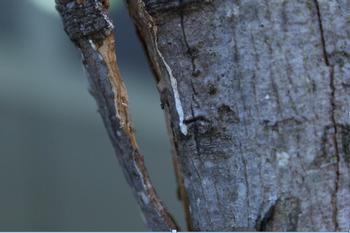Are your trees decaying?
-
Karen Gideon
-
While admiring large heritage trees in Marin you may see signs of plants in a death spiral, their canopies standing bare against the sky. It’s easy to point a finger at Sudden Oak Death as a culprit because it’s active and spreading in our county. But there are other pathogens responsible for decay and death in Marin trees. Here are some tips on what to look for as you keep a watchful eye on your trees.

We start with some tree basics. Functionally, the roots fasten the tree to the earth and absorb nutrients and water from the soil. The root collar attaches the roots to the trunk. Bark protects the tree from extreme temperatures, sunlight, injury, pests and keeps tissues moist. The trunk is the central structure, with specialized cells and layers for transporting water and nutrients up and down the tree, regeneration and growth. Stems and branches in the canopy also transport nutrients and leaves are photo-synthesizers that convert sunlight into chemical energy to be released in the tree.
Healthy trees benefit from the right amount of water in the soil, rich nutrients and oxygen for the roots, solid bark protection with no injuries, a root/trunk collar that’s exposed to air, and appropriate, careful pruning. As you examine your trees, watch for evidence that trees may be negatively impacted by gardening practices or pathogens.
Look at the canopy – if you see thinning crowns, yellowing, wilting leaves, or dieback, make note. Inspect for pruning wounds that have not healed and missing bark. Photograph any conks, fungi, deep trunk cracks or bleeding. Look for exit holes left by insects. Distressed trees are vulnerable to pathogens and insects that live naturally in the soil or travel in the air and water. Healthy trees live with the same threats but are able to resist infection because of their robust health.
You may find evidence of four common tree decay diseases - phytophthora, armillaria, verticillium wilt and cankers. While these diseases have similar presentation, which includes canopy die back, thinning of the crown, and slowed growth, they have distinguishable features to help you identify them.
Phytophthora (root and crown rot) lives in soil and infects woody plants when conditions are beneficial to the fungus. Prolonged moist conditions can cause root or crown rot in trees and shrubs. If buried below the soil level, the root crown area may die and become dark brown as it decays. A canker may form under the bark and weep a dark stain.
Armillaria root rot is caused by a fungus that infects cambial tissue responsible for growth. This causes the roots and trunk to decay and die. White fungal tissue forms underneath the bark that smells like mushrooms. Clusters of mushrooms may grow at the base of your tree in the fall or winter.
Cankers are caused by fungal or bacterial pathogens that enter the tree tissue after injury or infection. The tissue under the bark appears sunken and discolored. The canker may bleed, leaving a dark stain and fluid dripping from the bark. Fruiting bodies or conks may appear.
Verticillium wilt fungi infects deciduous trees in Marin. Common hosts include maple, ash, fuchsia, olive and rose bushes. This fungus attacks and darkens the xylem tissue, which delivers water and nutrients from the roots to the crown. The disease may focus on parts of the plant or girdle the trunk and kill the entire plant.
If you have identified issues on your trees, head to the Integrated Pest Management website http://ipm.ucanr.edu/index.html for help or find assistance from a local arborist.
To keep your trees vigorous, ensure good drainage, move mulch and soil away from the root collar, and avoid watering close to or on the tree. Make correct pruning cuts in the right season. If you’re doing hardscape or garden adjustments, take care that you don’t damage the roots of trees.

